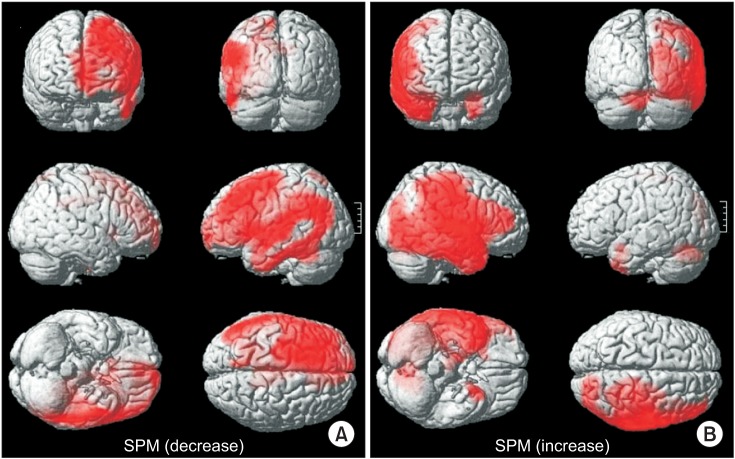Ann Rehabil Med.
2014 Dec;38(6):871-875. 10.5535/arm.2014.38.6.871.
Intracranial Hemorrhage in the Corpus Callosum Presenting as Callosal Disconnection Syndrome: FDG-PET and Tractography: A Case Report
- Affiliations
-
- 1Department of Rehabilitation Medicine, Keimyung University School of Medicine, Daegu, Korea. spineds@dsmc.or.kr
- 2Department of Neurosurgery, Keimyung University School of Medicine, Daegu, Korea.
- KMID: 2267102
- DOI: http://doi.org/10.5535/arm.2014.38.6.871
Abstract
- We report the findings of 18F-fluorodeoxyglocese positron emission tomography (FDG-PET) and diffusion tensor tractography (DTT) in a right-handed patient presenting with callosal disconnection syndrome, including alien hand syndrome, after an anterior communicating artery aneurysmal rupture. The 49-year-old patient had right hemiparesis and unintended movement of the right hand during action of the left hand. A brain magnetic resonance imaging revealed lesions in the upper part of the genu and body in the corpus callosum as well as hemorrhage in the inter-hemispheric fissure. We observed extensive disruption of corpus callosum fibers in the upper genu and trunk by DTT for the evaluation of inter-hemispheric connection. FDG-PET revealed severe hypometabolism in the left cerebral hemisphere, including basal ganglia and thalamus, and hypermetabolism in the right cerebral hemisphere. Based on findings of FDG-PET and DTT, the callosal disconnection syndrome presented in the patient could be the result of loss of transcallosal inhibition in the contralateral hemisphere.
MeSH Terms
Figure
Reference
-
1. Suwanwela NC, Leelacheavasit N. Isolated corpus callosal infarction secondary to pericallosal artery disease presenting as alien hand syndrome. J Neurol Neurosurg Psychiatry. 2002; 72:533–536. PMID: 11909919.2. Hong JH, Choi BY, Chang CH, Kim SH, Jung YJ, Byun WM, et al. Injuries of the cingulum and fornix after rupture of an anterior communicating artery aneurysm: a diffusion tensor tractography study. Neurosurgery. 2012; 70:819–823. PMID: 21937938.3. Kasanuki K, Iseki E, Fujishiro H, Yamamoto R, Higashi S, Minegishi M, et al. Neuropathological investigation of the hypometabolic regions on positron emission tomography with [18F] fluorodeoxyglucose in patients with dementia with Lewy bodies. J Neurol Sci. 2012; 314:111–119. PMID: 22041339.
Article4. Kim YK, Lee DS, Lee SK, Kim SK, Chung CK, Chang KH, et al. Differential features of metabolic abnormalities between medial and lateral temporal lobe epilepsy: quantitative analysis of (18)F-FDG PET using SPM. J Nucl Med. 2003; 44:1006–1012. PMID: 12843213.5. Wolpe N, Moore JW, Rae CL, Rittman T, Altena E, Haggard P, et al. The medial frontal-prefrontal network for altered awareness and control of action in corticobasal syndrome. Brain. 2014; 137(Pt 1):208–220. PMID: 24293266.
Article6. Maeshima S, Osawa A, Nishio D, Hirano Y, Kigawa H, Takeda H. Diffusion tensor MR imaging of the pyramidal tract can predict the need for orthosis in hemiplegic patients with hemorrhagic stroke. Neurol Sci. 2013; 34:1765–1770. PMID: 23430171.
Article7. Jang SH, Ahn SH, Sakong J, Byun WM, Choi BY, Chang CH, et al. Comparison of TMS and DTT for predicting motor outcome in intracerebral hemorrhage. J Neurol Sci. 2010; 290:107–111. PMID: 19914639.
Article8. Chang MC, Yeo SS, Jang SH. Callosal disconnection syndrome in a patient with corpus callosum hemorrhage: a diffusion tensor tractography study. Arch Neurol. 2012; 69:1374–1375. PMID: 22825395.
- Full Text Links
- Actions
-
Cited
- CITED
-
- Close
- Share
- Similar articles
-
- Total Excision of an Arterio-Venous Malformation of the Corpus Callosum: Case Report
- Intracrainal huge lipoma of the corpus callosum
- Anterior Callosal Disconnection Syndrome
- A Case of Acrocallosal Syndrome with Developmental Delay: A case report
- A Case of Agenesis of Corpus Callosum with Chromosome anomaly



